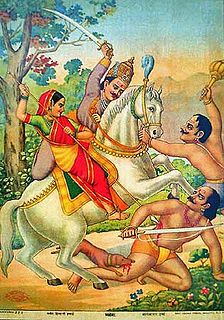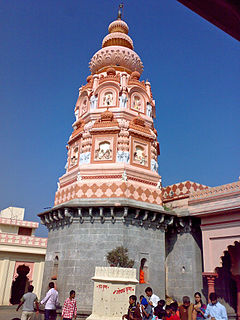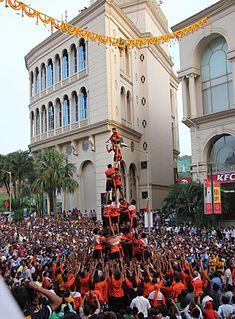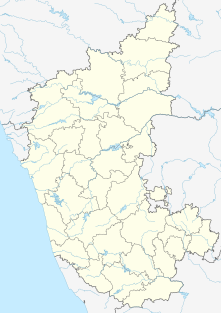
Dattatreya, Dattā or Dattaguru or Duttatreya, is a God and paradigmatic Sannyasi (monk) and one of the lords of Yoga in Hinduism. In many regions of India and Nepal, he is considered a deity. In Maharashtra, Goa, Karnataka and Gujarat, Dattatreya is considered to be an avatar (incarnation) of the three Hindu gods Brahma, Vishnu and Shiva, collectively known as Trimurti. In other regions, and some versions of texts such as Garuda Purana, Brahma Purana and Sattvata Samhita, he is an avatar of Maha Vishnu. In Dasam Granth, he is considered as Rudra Avtar.

Shiromani Namdev Maharaj, also transliterated was an Indian poet and saint from Narsi, Hingoli, Maharashtra India who is significant to the Varkari sect of Hinduism. Bhagat Namdev's writings were also recognized by the Gurus of Sikhism and are included in the holy book of Sikhism, the Sri Guru Granth Sahib. Namdev worshipped Vithoba, one of the many forms of lord Vishnu but Ronald McGregor states that in the larger context of Rama, Namdev was not referring to the hero described in the Hindu epic Ramayana, but to a pantheistic Ultimate Being.

Khandoba, Martanda Bhairava,Malhari, or Malhar is a Hindu deity worshiped as a manifestation of Shiva mainly in the Deccan plateau of India, especially in the state of Maharashtra. He is the most popular Kuladaivat in Maharashtra. He is also the patron deity of select warrior, farming castes, Dhangar community and Brahmin (priestly) castes as well as several of the hunter/gatherer tribes that are native to the hills and forests of this region. The Shaivaites of Khandoba has linkages with Hindu and Jain traditions, and also assimilates all communities irrespective of caste, including Muslims. The worship of Khandoba developed during the 9th and 10th centuries from a folk deity into a composite god possessing the attributes of Shiva, Bhairava, Surya and Karttikeya (Skanda). He is depicted either in the form of a Lingam, or as an image of a warrior riding on a bull or a horse. The foremost centre of Khandoba worship is Jejuri in Maharashtra. The legends of Khandoba, found in the text Malhari Mahatmya and also narrated in folk songs, revolve around his victory over demons Mani-malla and his marriages.

Vithoba, also known as Vi(t)thal(a) and Panduranga, is a Hindu deity predominantly worshipped in the Indian state of Maharashtra. He is generally considered as a manifestation of the god Vishnu or his avatar, Krishna. Vithoba is often depicted as a dark young boy, standing arms akimbo on a brick, sometimes accompanied by his main consort Rakhumai.
The Marathi people, also rendered as Marathis are an ethnolinguistic group who speak Marathi, an Indo-Aryan language as their native language. They inhabit the state of Maharashtra as well as districts bordering the state, such as Belgaum and Karwar of Karnataka and the state of Goa in western India as well as districts of southern Gujarat and parts of Madhya Pradesh. Their language, Marathi, is part of the Indo-Aryan language family. The term 'Maratha' is generally used by historians to refer to all Marathi-speaking peoples, irrespective of caste, although presently it refers to a set of Maharashtrian castes called Maratha. The Marathi community came into political prominence in the 17th century when the Marathas, under Chhatrapati Shivaji Maharaj, established the Maratha Empire, which is credited to a large extent for ending the Mughal rule.

Saptashrungi or Saptashringi is a site of Hindu pilgrimage situated 60 kilometres (37 mi) from Nashik in Indian state of Maharashtra. According to Hindu traditions, the goddess Saptashrungi Nivasini dwells within the seven mountain peaks. It is located in Nanduri, Kalwan taluka, a small village near Nashik in India. The Marathas and some Bhil tribes worship the goddess from a long time and some worship as their kuldaivat. There are 510 steps to climb the gad. Devotees visit this place in large numbers every day. The temple is also known popularly as one of the "three and half Shakti Peethas" of Maharashtra. The temple is also one among the 51 Shakti Peethas located on the Indian subcontinent and is a location where one of Sati's limbs, her right arm is reported to have fallen. Its half shaktipeeth among three and half shaktipeeth of Maharashtra.

Jalaram Bapa popularly known as Bapa was a Hindu saint from Gujarat, India. He was born on 4 November 1799, one week after the Hindu festival of Diwali, which is associated with his Iṣṭa-devatā Lord Rama.

Nagbhid, also known as Nagbhir, is a town and a municipal council in Chandrapur district in the Indian state of Maharashtra. It Connected to NH-353D and MSH-9.

Ravalnath(Konkani: रवळनाथ, Ravaḷhanāth), also widely known as Roulu, is a popular Hindu deity in Goa and the Sindhudurg district of coastal Maharashtra, in western India. Shrines of Ravalnath are also found in border areas of Belgaum specially in Karle and Uttar Kannada districts as well as coastal areas of Karnataka. He is worshipped as the main deity or an affiliate deity in most temples of Goa. He is often associated with the Pan-Hindu God Shiva.
The following is the list of temples located in Hyderabad

Maharashtra is the third largest state of India.It has a long history of Marathi saints of Varakari religious movement, such as Dnyaneshwar, Namdev, Chokhamela, Eknath and Tukaram which forms the one of bases of the culture of Maharashtra or Marathi culture. Maharashtra had huge influence over India in 17th-century King Chatrapati Shivaji Maharaj of Maratha Empire and his concept of Hindavi Swarajya which translates to self-rule of people.

Ganesh Jayanti (literally "Ganesha's birthday", also known as Magha shukla chaturthi, Tilkund chaturthi, and Varad chaturthi, is a Hindu festival. This occasion celebrates the birth day of Ganesha, the lord of wisdom. It is a popular festival particularly in the Indian state of Maharashtra and it is also celebrated in Goa held during the shukla paksha chaturthi day in the month of Maagha as per almanac, which corresponds to the Gregorian calendar month of January/February. In 2019, Shri Ganesh Jayanti falls on 8th February. The distinction between the Ganesh Jayanti and the more popular, almost pan-Indian Ganesh Chaturthi festival is that the latter festival is observed in the month of August/September. According to one tradition, Ganesh Chaturthi is also considered as the birthday of Ganesha. This festival of Ganesha is also called as the Tilo Chauth or Sakat Chauthis in Uttar Pradesh, where Ganesha is invoked on behalf of the son of a family. It is also called as Tilkund chaturthi in Maharashtra.

Shri Mayureshwar Mandir or Shri Moreshwar Temple(Marathi: श्री मोरेश्वर मंदीर) is a Hindu temple (mandir) dedicated to Ganesha, the elephant-headed god of wisdom. It is located in Moragaon in Pune District, about 65 km away from Pune city in the Indian state of Maharashtra. The temple is the starting and ending point of a pilgrimage of eight revered Ganesha temples called Ashtavinayaka.
Narasimhawadi commonly known as Narsobawadi or Narsobachi Wadi is a small town in Shirol Tahasil in Kolhapur district, Maharashtra. Narsobawadi gets its name from the presence of 'Shri Narasimha Saraswati', the Purna Avatar of Lord Dattatreya. With a lot of archaeological value this became a major pilgrim spot for many Shri Dattatrey devotee. Also, there is a confluence of the two rivers Panchganga and Krishna.

Dahi Handi or Utlotsavam is one of the festive events and a team sport during the Hindu festival Gokulashtami, which is also known as Krishna Janmashtami and celebrates the birth of Krishna.

Haragapur is a village in Belgaum district in the southern state of Karnataka, India. It is attached to NH-4. Places to visit are Shivaji Fort, Mallikarjun Temple & Navanath Mandir. Village is located on Hilltop. Language spoken here is Kannada (ಕನ್ನಡ)
Krishna Priya was a devotee of Lord Krishna
Religion in Maharashtra is characterized by the diversity of religious beliefs and practices. Maharashtra possesses six of the world's major religions; namely Hinduism, Islam, Buddhism, Jainism, Christianity, and Sikhism.

The Fiji Sanatan Society of Alberta, also known as Vishnu Mandir in Edmonton, Alberta, Canada is a modern-style Hindu temple that was built by some of the very first Fijian Hindu immigrants in Edmonton in 1984. Hindus have been living in Canada for over a century, especially in Edmonton. Fijian Hindus began to settle in Edmonton in larger proportions starting in the 1960s and 1970s. They conducted prayers and meditated in individual households via groups they formed in the community. Talks of the need of a temple started in 1983 by four major Hindu Bhakti groups in Edmonton at the time, Shree Sanatan Dharam Ramayan Society, Edmonton Geeta Ramayan Congregation, Edmonton Vedic Congregation and later joined by Edmonton Prem Society, the group founded the Sanatan Board and raised funds to buy a property for the temple. It became the first Fijian Hindu cultural society in all of Canada, and till date is the largest. It started as a small place of worship in the Balwin residential area, constructed out of an old Church building. Since then it has been renovated 2 times, first adding a basement, then in 2006 expanded further making it the second largest Hindu temple in Edmonton.

Tourism in Marathwada refers to tourism in Marathwada region of Maharashtra state of India. Aurangabad city is a regional headquarter of Marathwada and tourism capital of Maharashtra state. Out of 4 UNESCO World Heritage Sites in Maharashtra, 2 of them are in Marathwada. Also there are 110 monuments in Marathwada which are protected by Government of Maharashtra and recognized by Archaeological Survey of India. Marathwada is also important region for Religious tourism, out of 12 Jyotirlingas of Hindu God Shiva, 3 are in Marathwada. Hazur Sahib Nanded is the second holiest place in Sikhism after Harminder Sahib of Amritsir. There are also sufi shrines in Marathwada, most famous among them is Turabul Haq Dargah at Parbhani where thousands of people of all religion visits dargah annually. Pathri in Parbhani district is birthplace of Sai Baba of Shirdi and Sai Baba Birth Temple in Pathri is one of major religious tourism place in Marathwada.



















